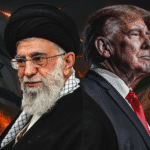by: The Washington Eye
In early June 2025, the United States witnessed a dramatic escalation in immigration enforcement as U.S. Immigration and Customs Enforcement (ICE) launched a wave of nationwide raids targeting undocumented immigrants and even some legal residents. These raids, directed under the Trump administration’s aggressive interior enforcement agenda, began around June 6 in Los Angeles and rapidly expanded to multiple cities, including Norristown (PA), Chicago, Baltimore, and several areas across Texas and Nebraska. Unlike previous efforts focused mainly on border enforcement, these operations marked a shift toward workplace arrests, raids at homes, places of worship, and even random stops in public spaces, raising alarm across immigrant communities and civil rights organizations.
The operations started in Southern California’s garment district, where over 100 arrests were made in the first few days. ICE agents raided clothing warehouses, car washes, Home Depot parking lots, and even churches like the Downey Memorial Christian Church. Many detainees were long-time residents with deep community ties, and in some cases, legal immigration status. Reports emerged of families being held in basement detention cells without access to food, clean water, or legal counsel for up to 48 hours. One particularly disturbing case involved a 23-year-old Zapotec man deported just 48 hours after being picked up at his job site. In cities like Norristown and Chicago’s South Loop, individuals were allegedly tricked into arrests after receiving deceptive texts about immigration appointments, prompting immediate backlash from immigrant advocacy groups.
The justification given by the administration was twofold: the need to increase deportation figures and a strategy to reassert federal authority. With border encounters down to around 12,000 per month from highs of over 200,000 during the Biden administration, ICE sought to shift its attention inward. The goal, according to Department of Homeland Security (DHS) officials, was to target those who had overstayed visas, had unresolved asylum claims, or had minor infractions—regardless of how long they had lived in the U.S. President Trump also framed the raids as a response to “restoring law and order,” a message accompanied by the deployment of thousands of federal troops. Around 4,000 National Guard members and 700 Marines were stationed in Los Angeles to support ICE and deter protests. The legality of this deployment is now under challenge, with California Governor Gavin Newsom filing lawsuits that were temporarily blocked by a federal court.
Public response to the raids was swift and intense. Massive protests erupted in Los Angeles, with demonstrators blocking streets in downtown and rallying in suburbs like Compton and Paramount. Thousands also took to the streets in cities like Seattle, Tucson, San Antonio, Chicago, New York, and Las Vegas. In Baltimore, ICE officers reportedly detained at least 16 people from stores and parking lots, prompting spontaneous protests with chants like “ICE out of Baltimore.” Community groups, legal aid organizations, and civil rights advocates condemned the operations, citing constitutional violations and due process concerns. Many accused ICE of racial profiling and acting without warrants. The American Civil Liberties Union (ACLU) and several immigrant defense organizations have filed urgent motions to halt deportations and demand immediate access to detained individuals.













